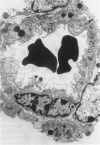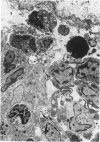Abstract
A mouse model of spotted fever group rickettsiosis, in which disease results from disseminated rickettsial infection of endothelial cells and vascular damage, was developed by intravenous inoculation of 6- to 8-week-old, male, Balb/c mice with Rickettsia australis. Animals developed progressively severe vasculitis, interstitial pneumonia, and multifocal hepatic necrosis. These lesions correlated with early disseminated infection of endothelial cells followed by growth and invasion of rickettsiae into perivascular cells. The dose of 2 x 10(6) organisms was uniformly lethal. Serum interleukin- (IL) 1, IL-6, and interferon (IFN) increased by day 3 and tumor necrosis factor (TNF) on day 5. TNF, IL-6, and IFN declined on day 7. Spleen cells responded to Rickettsia australis antigen by producing IFN, TNF, IL-1, and IL-6 on day 5, followed by lower quantities of these cytokines on day 7. Despite the production of antibodies, IFN, TNF, IL-1, and IL-6, a lethal outcome occurred frequently. A decreased ability to secrete IL-2 suggests an element of infection-associated immunosuppression.
Full text
PDF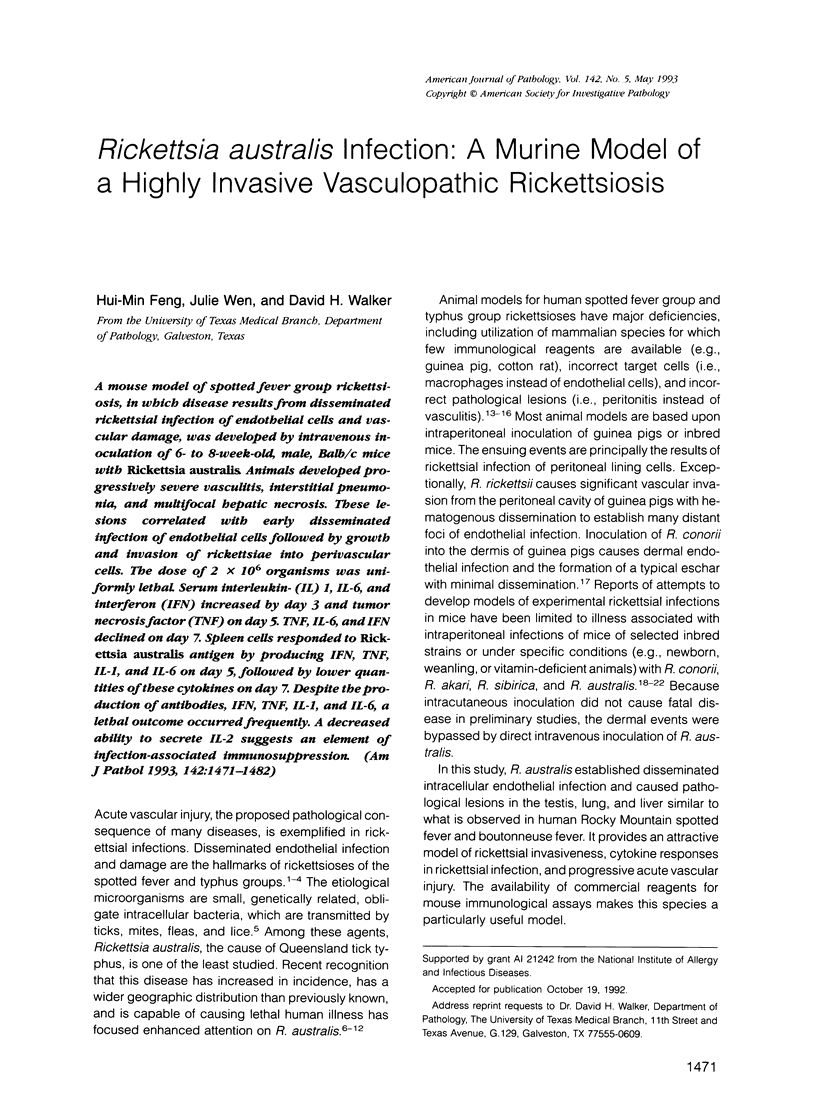
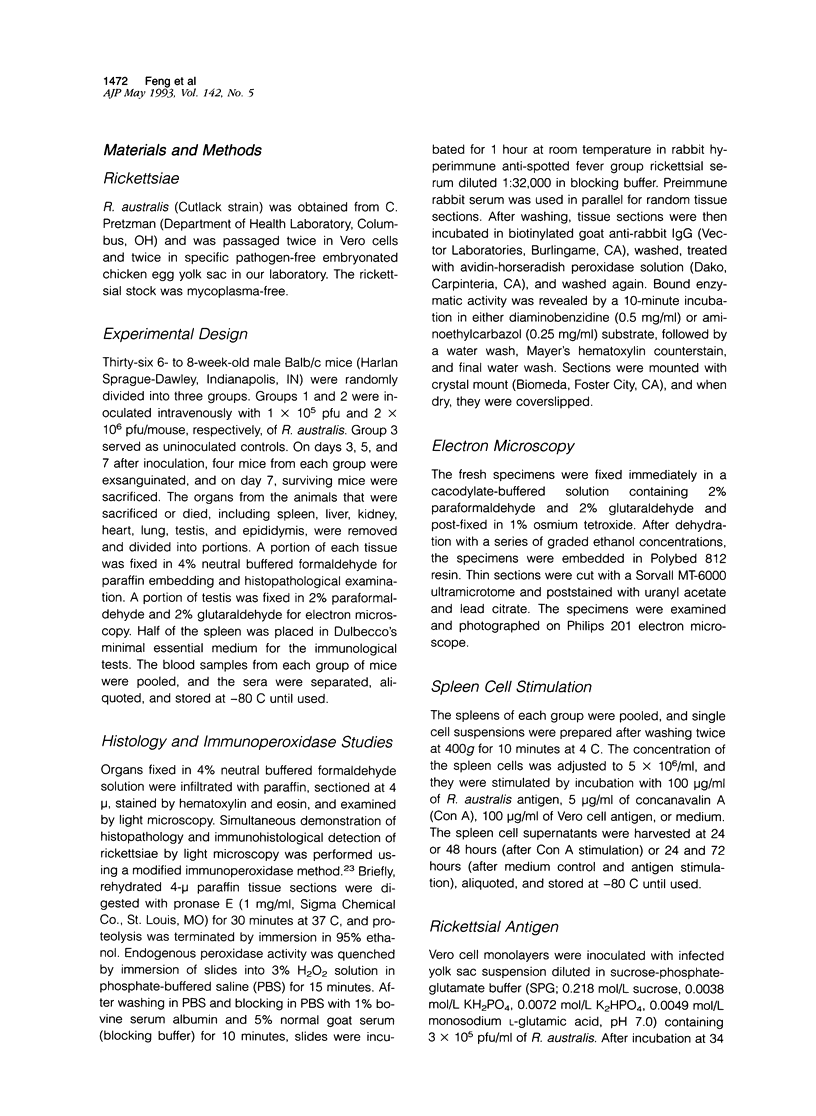
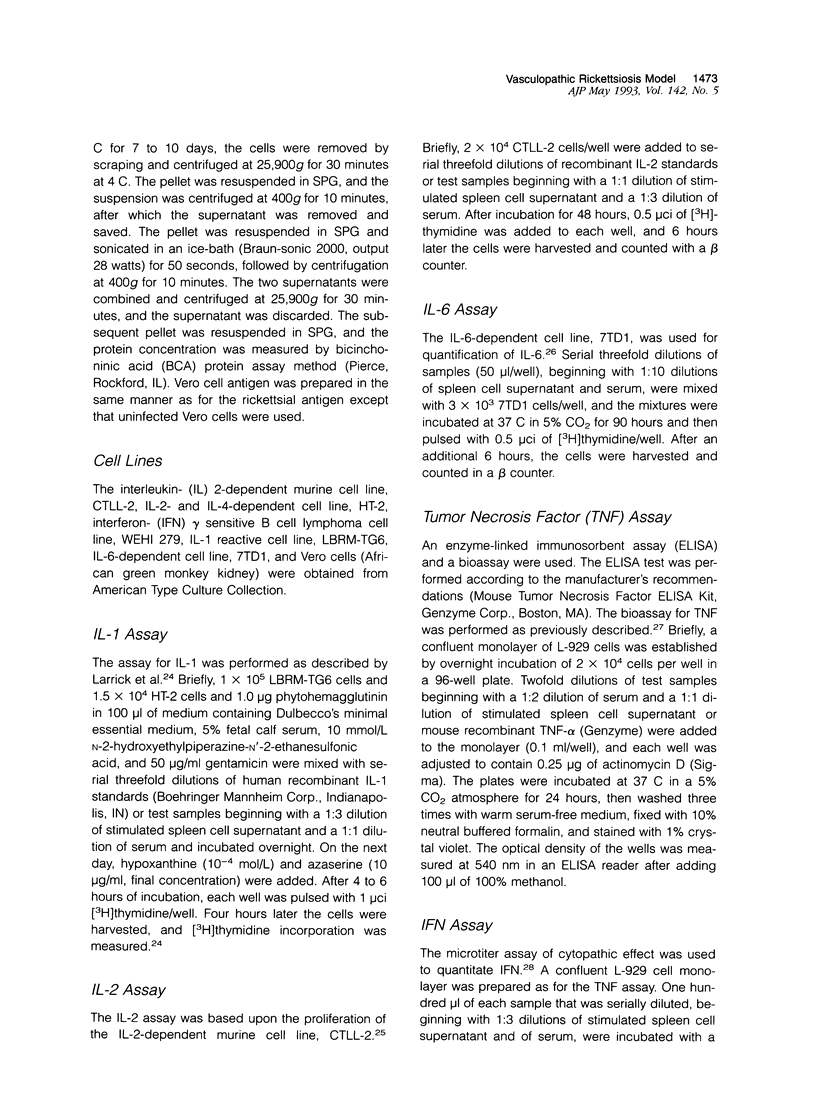
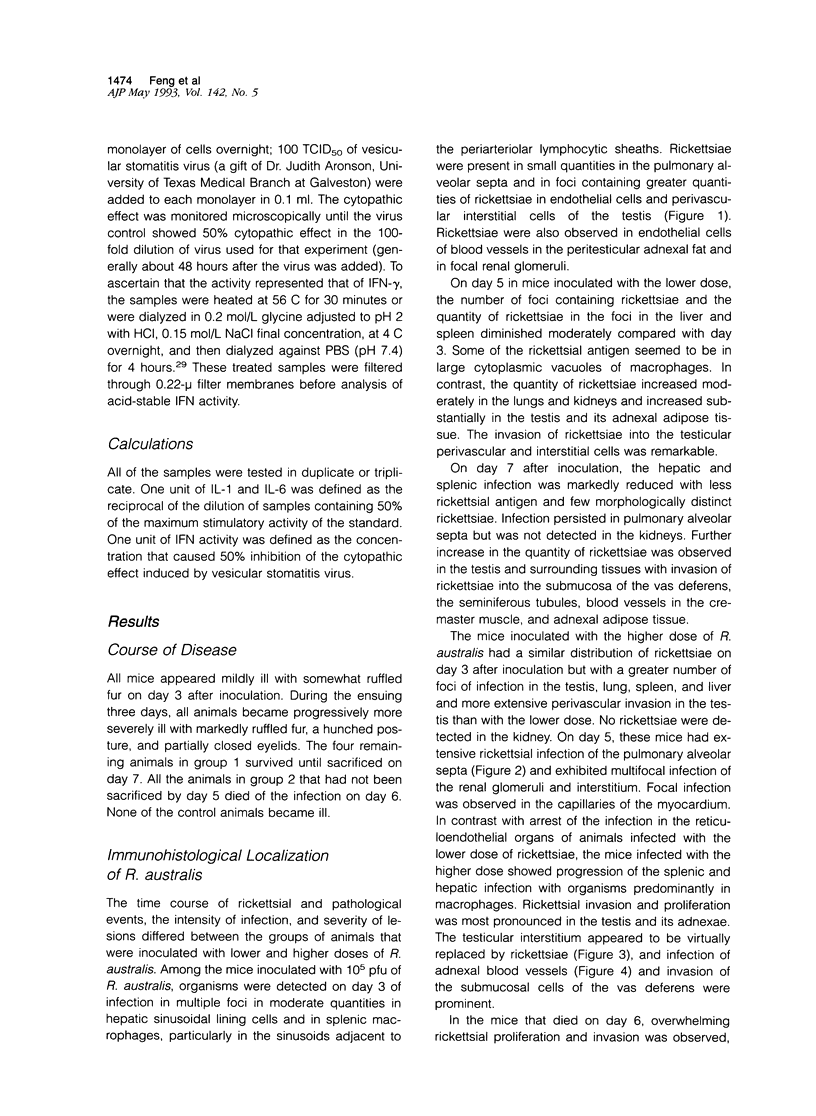
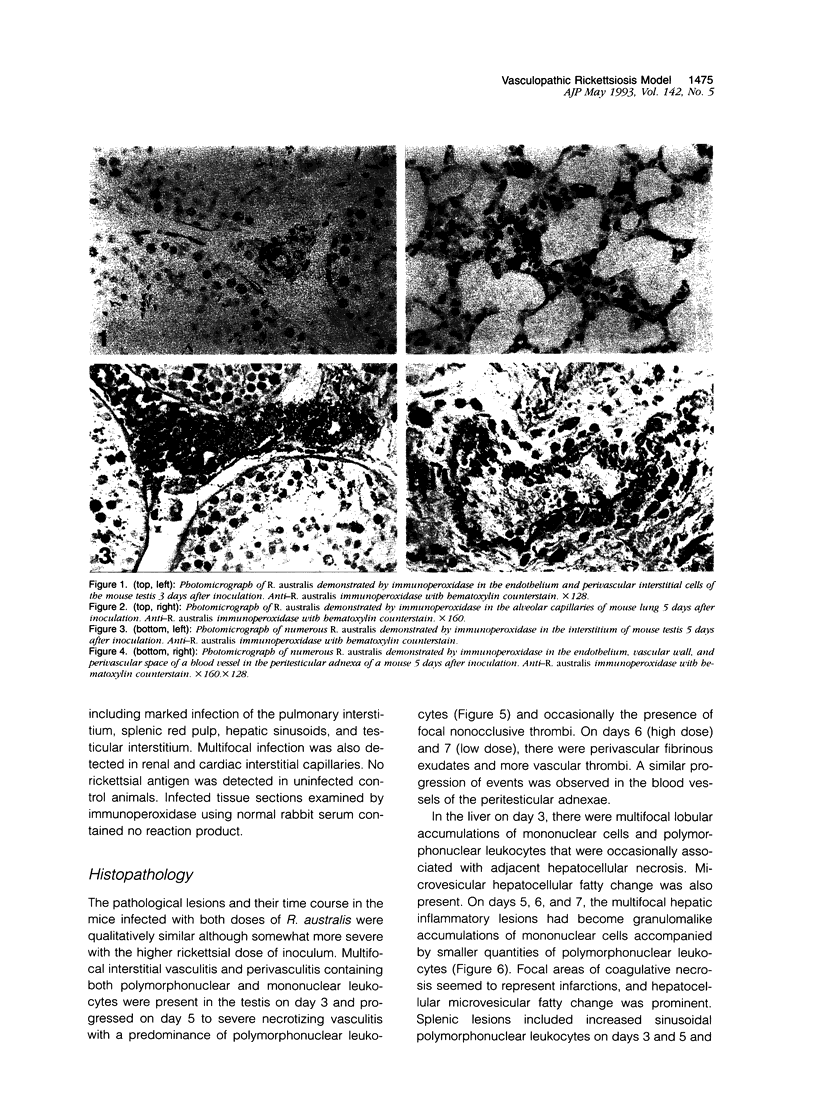

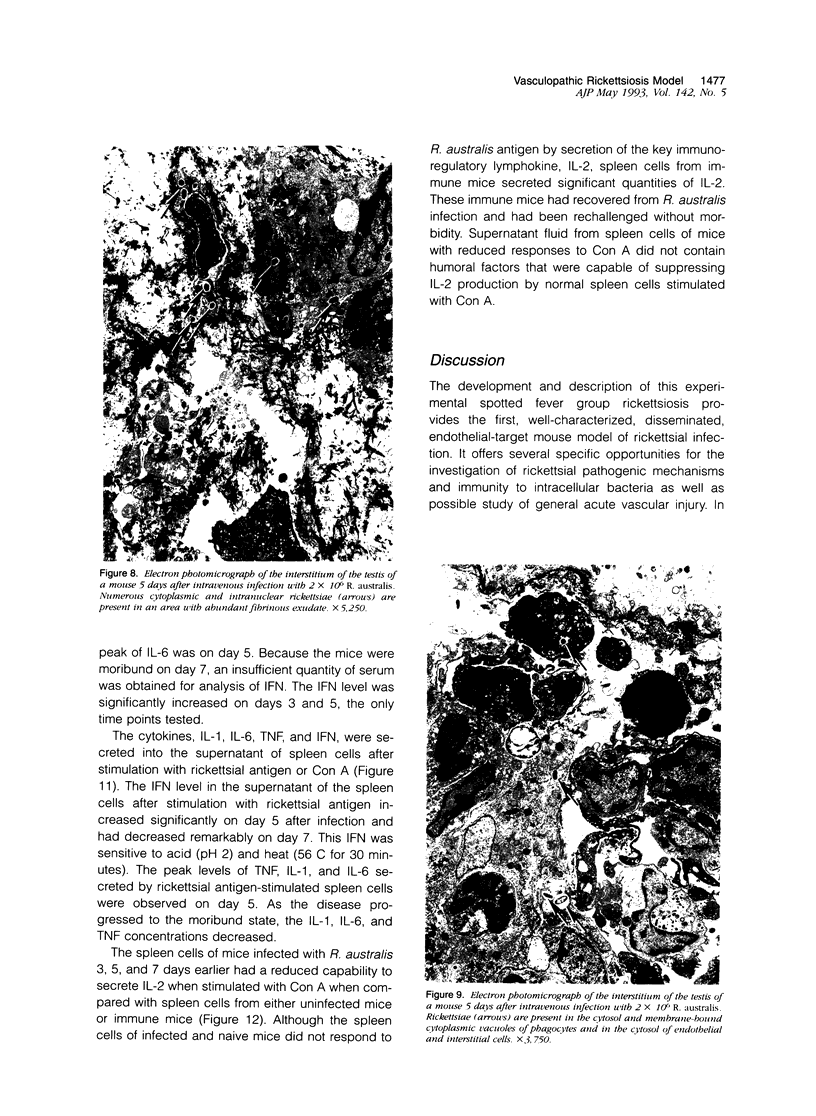

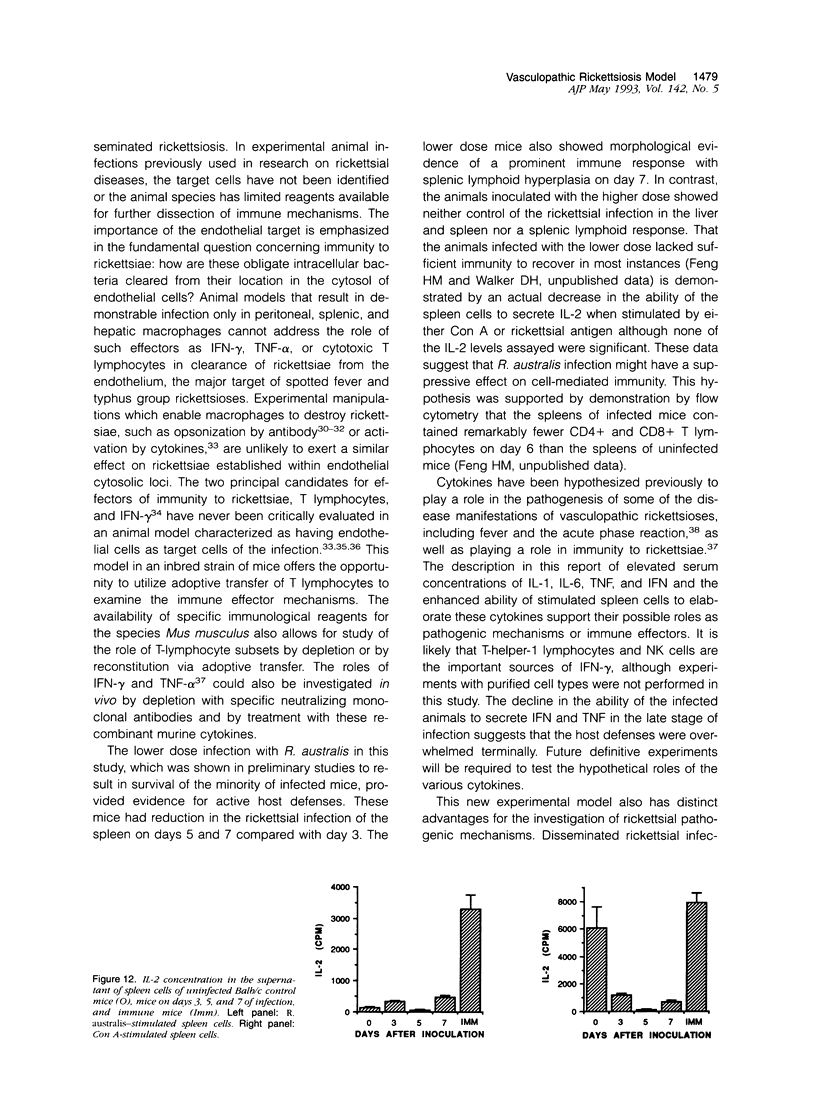
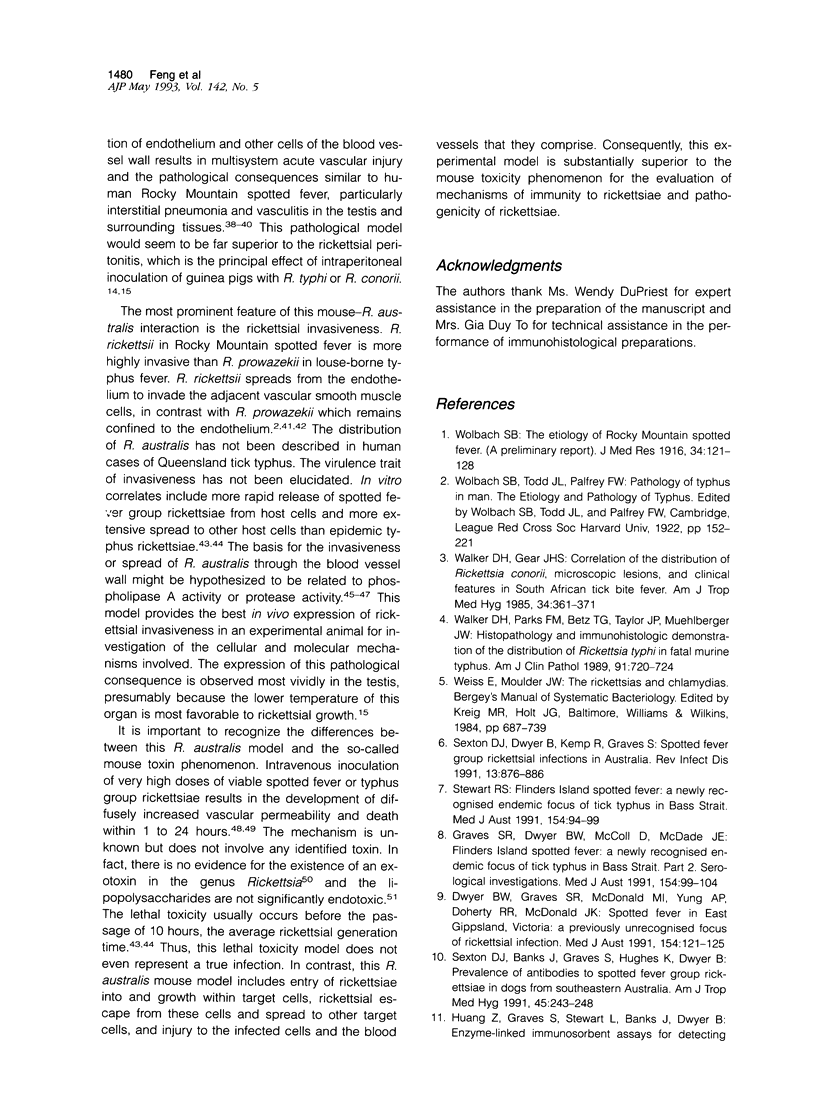

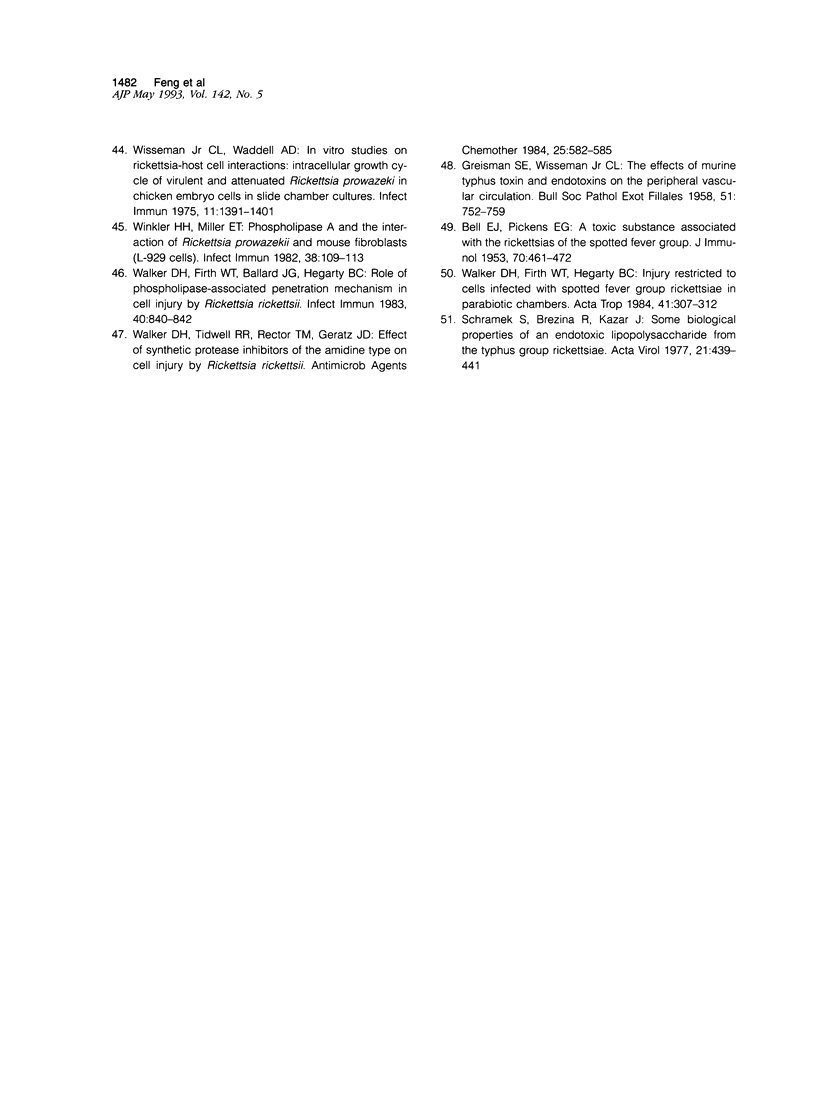
Images in this article
Selected References
These references are in PubMed. This may not be the complete list of references from this article.
- Anderson G. W., Jr, Osterman J. V. Host defenses in experimental rickettsialpox: genetics of natural resistance to infection. Infect Immun. 1980 Apr;28(1):132–136. doi: 10.1128/iai.28.1.132-136.1980. [DOI] [PMC free article] [PubMed] [Google Scholar]
- BELL E. J., PICKENS E. G. A toxic substance associated with the rickettsias of the spotted fever group. J Immunol. 1953 May;70(5):461–472. [PubMed] [Google Scholar]
- Dumler J. S., Gage W. R., Pettis G. L., Azad A. F., Kuhadja F. P. Rapid immunoperoxidase demonstration of Rickettsia rickettsii in fixed cutaneous specimens from patients with Rocky Mountain spotted fever. Am J Clin Pathol. 1990 Mar;93(3):410–414. doi: 10.1093/ajcp/93.3.410. [DOI] [PubMed] [Google Scholar]
- Dwyer B. W., Graves S. R., McDonald M. I., Yung A. P., Doherty R. R., McDonald J. K. Spotted fever in East Gippsland, Victoria: a previously unrecognised focus of rickettsial infection. Med J Aust. 1991 Jan 21;154(2):121–125. doi: 10.5694/j.1326-5377.1991.tb120998.x. [DOI] [PubMed] [Google Scholar]
- Eisemann C. S., Nypaver M. J., Osterman J. V. Susceptibility of inbred mice to rickettsiae of the spotted fever group. Infect Immun. 1984 Jan;43(1):143–148. doi: 10.1128/iai.43.1.143-148.1984. [DOI] [PMC free article] [PubMed] [Google Scholar]
- Feng H. M., Walker D. H., Wang J. G. Analysis of T-cell-dependent and -independent antigens of Rickettsia conorii with monoclonal antibodies. Infect Immun. 1987 Jan;55(1):7–15. doi: 10.1128/iai.55.1.7-15.1987. [DOI] [PMC free article] [PubMed] [Google Scholar]
- Gayá A., de la Calle O., Yagüe J., Alsinet E., Fernández M. D., Romero M., Fabregat V., Martorell J., Vives J. IL-4 inhibits IL-2 synthesis and IL-2-induced up-regulation of IL-2R alpha but not IL-2R beta chain in CD4+ human T cells. J Immunol. 1991 Jun 15;146(12):4209–4214. [PubMed] [Google Scholar]
- Graves S. R., Dwyer B. W., McColl D., McDade J. E. Flinders Island spotted fever: a newly recognised endemic focus of tick typhus in Bass Strait. Part 2. Serological investigations. Med J Aust. 1991 Jan 21;154(2):99–104. doi: 10.5694/j.1326-5377.1991.tb120994.x. [DOI] [PubMed] [Google Scholar]
- Kokorin I. N., Kabanova E. A., Shirokova E. M., Abrosimova G. E., Rybkina N. N., Pushkareva V. i. Role of T lymphocytes in Rickettsia conorii infection. Acta Virol. 1982 Jan;26(1-2):91–97. [PubMed] [Google Scholar]
- Lange J. V., Walker D. H. Production and characterization of monoclonal antibodies to Rickettsia rickettsii. Infect Immun. 1984 Nov;46(2):289–294. doi: 10.1128/iai.46.2.289-294.1984. [DOI] [PMC free article] [PubMed] [Google Scholar]
- Larrick J. W., Brindley L., Doyle M. V. An improved assay for the detection of interleukin 1. J Immunol Methods. 1985 May 10;79(1):39–45. doi: 10.1016/0022-1759(85)90389-8. [DOI] [PubMed] [Google Scholar]
- Li H., Jerrells T. R., Spitalny G. L., Walker D. H. Gamma interferon as a crucial host defense against Rickettsia conorii in vivo. Infect Immun. 1987 May;55(5):1252–1255. doi: 10.1128/iai.55.5.1252-1255.1987. [DOI] [PMC free article] [PubMed] [Google Scholar]
- Li H., Lenz B., Walker D. H. Protective monoclonal antibodies recognize heat-labile epitopes on surface proteins of spotted fever group rickettsiae. Infect Immun. 1988 Oct;56(10):2587–2593. doi: 10.1128/iai.56.10.2587-2593.1988. [DOI] [PMC free article] [PubMed] [Google Scholar]
- Manor E., Sarov I. Inhibition of Rickettsia conorii growth by recombinant tumor necrosis factor alpha: enhancement of inhibition by gamma interferon. Infect Immun. 1990 Jun;58(6):1886–1890. doi: 10.1128/iai.58.6.1886-1890.1990. [DOI] [PMC free article] [PubMed] [Google Scholar]
- Moe J. B., Mosher D. F., Kenyon R. H., White J. D., Stookey J. L., Bagley L. R., Fine D. P. Functional and morphologic changes during experimental Rocky Mountain spotted fever in guinea pigs. Lab Invest. 1976 Sep;35(3):235–245. [PubMed] [Google Scholar]
- Montenegro N. R., Walker D. H., Hegarty B. C. Infection of genetically immunodeficient mice with Rickettsia conorii. Acta Virol. 1984 Nov;28(6):508–514. [PubMed] [Google Scholar]
- POPE J. H. The isolation of a rickettsia resembling Rickettsia australis in South East Queensland. Med J Aust. 1955 May 21;42(1 21):761–763. [PubMed] [Google Scholar]
- Schramek S., Brezina R., Kazár J. Some biological properties of an endotoxic lipopolysaccharide from the typhus group rickettsiae. Acta Virol. 1977 Sep;21(5):439–441. [PubMed] [Google Scholar]
- Sexton D. J., Banks J., Graves S., Hughes K., Dwyer B. Prevalence of antibodies to spotted fever group rickettsiae in dogs from southeastern Australia. Am J Trop Med Hyg. 1991 Aug;45(2):243–248. doi: 10.4269/ajtmh.1991.45.243. [DOI] [PubMed] [Google Scholar]
- Sexton D. J., Dwyer B., Kemp R., Graves S. Spotted fever group rickettsial infections in Australia. Rev Infect Dis. 1991 Sep-Oct;13(5):876–886. doi: 10.1093/clinids/13.5.876. [DOI] [PubMed] [Google Scholar]
- Sexton D. J., King G., Dwyer B. Fatal Queensland tick typhus. J Infect Dis. 1990 Sep;162(3):779–780. doi: 10.1093/infdis/162.3.779. [DOI] [PubMed] [Google Scholar]
- Snyder J. C., Anderson C. R. THE SUSCEPTIBILITY OF THE EASTERN COTTON RAT, SIGMODON HISPIDUS HISPIDUS, TO EUROPEAN TYPHUS. Science. 1942 Jan 2;95(2453):23–23. doi: 10.1126/science.95.2453.23. [DOI] [PubMed] [Google Scholar]
- Spangelo B. L., MacLeod R. M., Isakson P. C. Production of interleukin-6 by anterior pituitary cells in vitro. Endocrinology. 1990 Jan;126(1):582–586. doi: 10.1210/endo-126-1-582. [DOI] [PubMed] [Google Scholar]
- Stewart R. S. Flinders Island spotted fever: a newly recognised endemic focus of tick typhus in Bass Strait. Part 1. Clinical and epidemiological features. Med J Aust. 1991 Jan 21;154(2):94–99. doi: 10.5694/j.1326-5377.1991.tb120993.x. [DOI] [PubMed] [Google Scholar]
- Suzuki F., Pollard R. B. Alterations of interferon production in a mouse model of thermal injury. J Immunol. 1982 Nov;129(5):1806–1810. [PubMed] [Google Scholar]
- Walker D. H., Crawford C. G., Cain B. G. Rickettsial infection of the pulmonary microcirculation: the basis for interstitial pneumonitis in Rocky Mountain spotted fever. Hum Pathol. 1980 May;11(3):263–272. doi: 10.1016/s0046-8177(80)80008-6. [DOI] [PubMed] [Google Scholar]
- Walker D. H., Firth W. T., Ballard J. G., Hegarty B. C. Role of phospholipase-associated penetration mechanism in cell injury by Rickettsia rickettsii. Infect Immun. 1983 May;40(2):840–842. doi: 10.1128/iai.40.2.840-842.1983. [DOI] [PMC free article] [PubMed] [Google Scholar]
- Walker D. H., Firth W. T., Hegarty B. C. Injury restricted to cells infected with spotted fever group rickettsiae in parabiotic chambers. Acta Trop. 1984 Dec;41(4):307–312. [PubMed] [Google Scholar]
- Walker D. H., Gear J. H. Correlation of the distribution of Rickettsia conorii, microscopic lesions, and clinical features in South African tick bite fever. Am J Trop Med Hyg. 1985 Mar;34(2):361–371. doi: 10.4269/ajtmh.1985.34.361. [DOI] [PubMed] [Google Scholar]
- Walker D. H., Harrison A., Henderson F., Murphy F. A. Identification of Rickettsia rickettsii in a guinea pig model by immunofluorescent and electron microscopic techniques. Am J Pathol. 1977 Feb;86(2):343–358. [PMC free article] [PubMed] [Google Scholar]
- Walker D. H., Parks F. M., Betz T. G., Taylor J. P., Muehlberger J. W. Histopathology and immunohistologic demonstration of the distribution of Rickettsia typhi in fatal murine typhus. Am J Clin Pathol. 1989 Jun;91(6):720–724. doi: 10.1093/ajcp/91.6.720. [DOI] [PubMed] [Google Scholar]
- Walker D. H., Tidwell R. R., Rector T. M., Geratz J. D. Effect of synthetic protease inhibitors of the amidine type on cell injury by Rickettsia rickettsii. Antimicrob Agents Chemother. 1984 May;25(5):582–585. doi: 10.1128/aac.25.5.582. [DOI] [PMC free article] [PubMed] [Google Scholar]
- Winkler H. H., Miller E. T. Phospholipase A and the interaction of Rickettsia prowazekii and mouse fibroblasts (L-929 cells). Infect Immun. 1982 Oct;38(1):109–113. doi: 10.1128/iai.38.1.109-113.1982. [DOI] [PMC free article] [PubMed] [Google Scholar]
- Winkler H. H., Turco J. Rickettsia prowazekii and the host cell: entry, growth and control of the parasite. Curr Top Microbiol Immunol. 1988;138:81–107. [PubMed] [Google Scholar]
- Wisseman C. L., Jr, Edlinger E. A., Waddell A. D., Jones M. R. Infection cycle of Rickettsia rickettsii in chicken embryo and L-929 cells in culture. Infect Immun. 1976 Oct;14(4):1052–1064. doi: 10.1128/iai.14.4.1052-1064.1976. [DOI] [PMC free article] [PubMed] [Google Scholar]
- Wisseman C. L., Jr, Waddell A. D. In vitro studies on rickettsia-host cell interactions: intracellular growth cycle of virulent and attenuated Rickettsia prowazeki in chicken embryo cells in slide chamber cultures. Infect Immun. 1975 Jun;11(6):1391–1404. doi: 10.1128/iai.11.6.1391-1401.1975. [DOI] [PMC free article] [PubMed] [Google Scholar]









